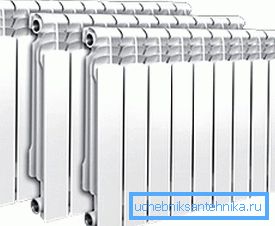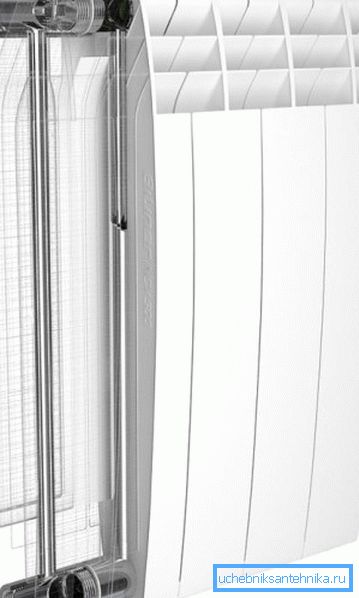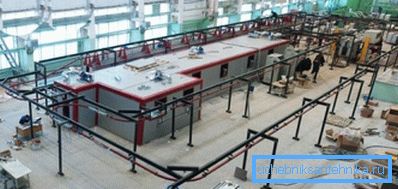Aluminum radiator volume: specifications and power
For autonomous heating at the moment the construction market offers a large number of different heating devices, including aluminum, and their power depends on how much water is in the aluminum radiator, that is, on the capacity.
Of course, this is not the only factor affecting heat transfer - the configuration of the heater is also included here, but at the moment we are talking about sectional batteries, the size of which (number of sections) can be changed at will. In more detail about these heaters we will talk below in the text, and besides, we still want to offer you a thematic demonstration of the video in this article.

Aluminum heaters
Specifications
Note! If you want to buy quality products, then when you buy, pay attention to its weight. Thus, the instruction indicates that the mass of one section cannot be less than a kilogram, and the assembly of a ten-section battery with nipples cannot be less than 11 kg!

The volume of one section of an aluminum radiator largely depends on the method of its manufacture, and there are only two such methods - it is injection molding and extrusive.
- Experts consider production by the injection method to be more technologically advanced - it allows to get an all-welded sectional building. Of course, there is a seam, but it is performed by resistance welding. Of course, the price of such products is somewhat higher.
- But the pressing or extrusion method is a process where several elements are extruded from an alloy with a very high Al content (98%).. They are connected mechanically and high quality glue is used. The products obtained by extrusion, has a high resistance to corrosion, and its main drawback (weak point) can be called a mechanical connection method.

- Not only the volume of water in the aluminum radiator of heating, but also its shape - ribbed and sectional helps determine the performance properties.. The ribbing allows the greatest possible contact with the air in the room, which contributes to its rapid heating, and the sections allow you to reduce and increase the device as needed, depending on the volume of the heated room.
- In addition, corrosion protection is painting in two layers.. Painting work is usually performed on specialized production lines, which are served by only a few people (see photo above). Such processes are carried out in two stages - first, the first layer is applied by anaphoresis, which provides anti-corrosion protection and color stability for the next coating. The second layer is already sprayed on the powder enamel, which we see on the finished product.
| Name | Distance between axes (mm) | Dimensions (mm) | Diameter of collectors (inch) | Heat transfer coefficient | The volume of water in the section (l) | Heat transfer (W) | Weight |
| GLOBAL KLASS | 800 | 80x80x882 | 1 / 2-3 / 4 | 5.58 | 0.59 | 254 | 2.16 |
| 700 | 80x80x782 | 1 / 2-3 / 4 | 5.83 | 0.54 | 232 | 1.91 | |
| 600 | 80x80x682 | 1 / 2-3 / 4 | 6.0 | 0.49 | 204 | 1.66 | |
| 500 | 80x80x585 | 1 / 2-3 / 4 | 6.44 | 0.44 | 187 | 1.41 | |
| 350 | 80x80x432 | 1 / 2-3 / 4 | 6.76 | 0.37 | 131 | 1.01 | |
| GLOBAL VOX | 800 | 80x80x890 | 1 / 2-3 / 4 | 5.69 | 0.56 | 276 | 2.21 |
| 500 | 80x80x590 | 1 / 2-3 / 4 | 6.34 | 0.46 | 193 | 1.45 | |
| 350 | 80x80x440 | 1 / 2-3 / 4 | 6.79 | 0.35 | 145 | 1.12 | |
| GL 200/80 / D | 200 | 80x80x290 | 1 / 2-3 / 4 | 7.79 | 0.52 | 165 | 1.42 |
| GL 350/80 / D | 350 | 80x80x440 | 1 / 2-3 / 4 | 7.19 | 0.7 | 247 | 2.21 |
| GLOBAL VIP | 500 | 80x80x590 | 1 / 2-3 / 4 | 6.37 | 0.43 | 195 | 1.62 |
| 350 | 80x80x440 | 1 / 2-3 / 4 | 6.73 | 0.35 | 147 | 1,3 | |
| GLOBAL VIX R | 500 | 80x80x590 | 1 / 2-3 / 4 | 6.49 | 0.43 | 190 | 1.16 |
| 350 | 80x80x440 | 1 / 2-3 / 4 | 6.8 | 0.36 | 145 | 1.57 | |
| GLOBAL ISEO | 500 | 80x80x582 | 1 / 2-3 / 4 | 6.56 | 0.44 | 180 | 1.31 |
| 350 | 80x80x432 | 1 / 2-3 / 4 | 6.93 | 0.34 | 152 | 1.05 | |
| 600 | 80x80x682 | 1 / 2-3 / 4 | 6.35 | 0.47 | 203 | 1.5 | |
| 700 | 80x80x782 | 1 / 2-3 / 4 | 6.16 | 0.52 | 232 | 1.68 |
Table: dimensions, mass, heat transfer and volume of the aluminum radiator section
Doing power calculations
Note. In order for all calculations to correspond to reality, the place where you are going to install the radiator is important. So, as a rule, they do it under the window - the warm air from the heater, rising up, creates a kind of screen that protects the room from cold streams moving from the glass.

So, to calculate the volume of water in an aluminum radiator, as you understand, does not constitute any problem - for this it is enough to know the volume of one section and their number, and then add these values together (see table).
In the same way, you can determine the battery capacity if you know the nominal value of one section and their number, but let's see how to calculate this indicator for a room of a certain size.
If the height of the ceilings does not exceed 2.7 m, then calculations can be conducted by quadrature, and for example we take a room with an area (S) of 4.55.5 m, then S = 4.5 * 5.5 = 24.75 m2, and use GLOBAL KLASS radiator with a power section of 232 watts.
To calculate the number of sections, we need the formula S * 100 / P, where 100 is the required number of watts per square meter, and P is the power of one section. So, K number of sections = S * 100 / P = 24.75 * 100/232 = 10.66 or 11 sections (the volume of water in one section of the aluminum radiator here is 0.54 liters, which means 0, 54 * 11 = 54.54 liters) .
Now let's take the parameters of the same heating device and the same area, but the height of the ceilings is 3m, then we will need to do calculations per m3, where 41W of heat transfer is needed.
The volume of the room (V) we get is 4.5 * 5.5 * 3 = 74.25 m3, so we divide it by the capacity of one section. We will have K number of sections = V * 41 / P = 74.25 * 41/232 = 13.1 or 14 sections, so that there is a stock.
Conclusion
As you can see, with your own hands you can not only install, but calculate the required number of sections for selecting the necessary radiator power and determine how much water you will have to heat.
Such calculations are extremely necessary in the repair or construction, because, thanks to them, we do not just achieve maximum comfort in the room, but also determine our future expenses, that is, we partially form the family budget.